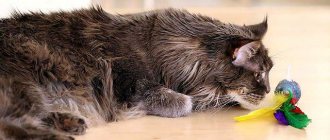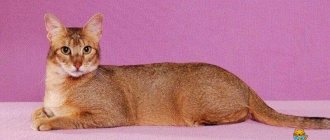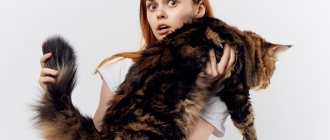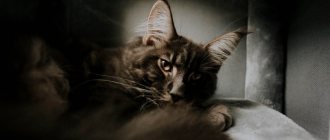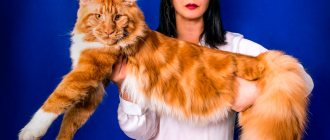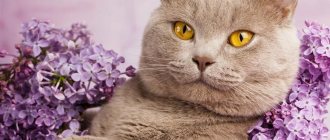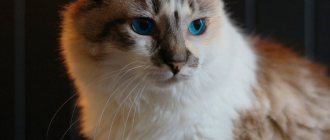The Maine Coon breed is great for illustrating all the big cats. He is healthy and hardy, well socialized and ready to communicate with people.
The only problem in care and maintenance is that you cannot treat such an animal as an ordinary decorative cat. You will have to allocate more space, get used to regular combing of long hair and remember that the daily diet of a Maine Coon is almost 2 times more than that of a regular cat.
Preparing for the arrival of a Maine Coon kitten at home
A novice owner needs to familiarize himself in advance with the features of keeping an elite Maine Coon:
- Allocate space for your pet to relax and play – the entertainment area of a big cat should be spacious.
- It is necessary to take care of products for caring for your pet’s fur; it is necessary to accustom your Maine Coon to combing from the first days of acquaintance.
- Find a secluded place for the toilet tray.
- Buy suitable toys for your cat - little Maine Coons love to run after a wind-up mouse or jump for a wand with feathers.
This is interesting! As a child, the Maine Coon most strongly demonstrates the nature of its freedom-loving ancestors. A representative of this breed instinctively learns to hide, sneak up and suddenly attack, and catch prey, although this skill will not be useful to him in later life.
Toilet and tray training
It is necessary to monitor the pet and its behavior.
If he moves restlessly, tries to find a secluded place, meows, then these may be signs that the cat wants to go to the toilet.
You need to carefully pick up the coon, take him to the tray and put him in it, not allowing him to leave until he goes to the toilet. You should also take your pet to the toilet after sleeping and eating. It is necessary to ensure that the tray is clean - strong unpleasant odors repel animals.
During the first month, you can limit the pet’s space, leaving him with a minimum of opportunities to relieve himself in the wrong place. If a puddle is still noticed outside the tray, you should blot it with a napkin, which should then be placed in the tray - this smell will attract the cat and indicate to him the correct place for the toilet.
You cannot scold or physically punish a cat - this will only scare it away.
Features of caring for a Maine Coon kitten
Maine Coon kittens, which are purchased from a nursery at the age of 3 months, already have initial socialization skills, know how to eat and go to the toilet correctly. In this case, the pet's training process is simplified, and the animal's introduction to its new home must be carried out according to the breeder's recommendations.
You cannot suddenly change the rules of behavior of a young cat; its innate instincts will not allow it to quickly adapt.
Caring for Maine Coon kittens involves gradually and unobtrusively introducing them to an unusual environment. The owner must spend a lot of time with the pet and participate in games.
Historical reference
Maine Coons appeared 150 years ago in the USA (Maine). No one bred the breed specifically. It is considered indigenous, that is, formed under the influence of environmental factors. According to one version, the ancestors were long-haired cats imported from Asia, which crossed with local animals with short hair. The name of the breed comes from the words:
- Maine is the name of the US state;
- coon is a component of the word “raccoon”, translated as “raccoon”.
Another name for Maine Coons is raccoon cats. They were first learned about in 1885; the animals were presented at a local fair. Having gained success in America, large cats covered with thick, long hair became popular in other countries. Previously, the standards were more stringent; only the “black marble” color was recognized: gray, white stains on a black background (at present, purebred individuals can have any color).
At the beginning of the 20th century, the breed was in danger of dying out as Persians became fashionable. However, since the mid-20s, kunas have gained popularity again. Now in America they occupy second place, in Europe they are among the top five. Maine Coons were brought to Russia in the early 90s, and over time, dozens of nurseries appeared. Representatives of the breed successfully participate in international competitions, receiving high awards.
How and what to feed a Maine Coon cat
A nutritious diet plays an important role in a cat’s development. In order for the kitten to grow up healthy, you need to follow the recommendations of experts regarding feeding the Maine Coon.
- At one month of age, the kitten should receive mother's milk. If for some reason the baby is left without natural complementary food, it is replaced with diluted goat food or a special mixture for kittens. Later, liquid porridge, diluted meat puree, kefir, egg yolk, and soft cottage cheese are additionally introduced into the pet’s menu.
- An early need for protein food is the main nutritional feature of Maine Coon kittens. At 2 months, sea fish and offal are gradually added to the pet’s diet. For the proper development of teeth and gums, the baby needs to chew hard food and small trimmings of meat are suitable for this. This is how the shape of the jaws is formed (they differ in Maine Coons from other cats), the movement of products through the gastrointestinal tract improves, and hygienic processes in the oral cavity are stimulated. Kittens of this breed should not be overfed. They should eat little by little, but often (at least 6 times a day).
- It is recommended to feed a 3-month-old Maine Coon less often - 5 approaches to the bowl. The diet is varied with vegetables, which are ground and mixed into porridge seasoned with vegetable oil. Also, your pet should receive fermented milk products and greens every day.
- From 4 months to six months, the main components of the menu no longer change, only the portion increases and the number of feedings of the young cat decreases. Maine Coon nutrition with natural products is calculated using a universal formula - per day an animal of this breed eats a norm approximately equal to 10% of its weight.
During this period, it is necessary to determine the feeding option - leave the cat on regular food or switch it to industrial food. Every decision has positive and negative sides.
The first method will require increased financial costs, taking into account the individual characteristics of the breed in maintenance.
Dry or wet industrial products for feeding the Maine Coon are selected according to the recommendations of the manufacturers and the prescriptions of veterinarians for a specific breed of cat.
Important! Unlike other breeds, the Maine Coon is fully formed only by the age of 3-4 years. Before this period, the cat grows up, and a person needs to take this circumstance into account when organizing the diet of a furry pet.
Issues of raising and training Maine Coon cats
Observing daily behavior helps a person better understand the animal. This method is used in training - the easiest way is to teach a cat to do exactly what is inherent in its nature.
The habits of the Maine Coon cannot be called exclusively cat-like. Generations of wild ancestors and natural selection have led to the breed being credited with canine “manners.” For example, sometimes Maine Coons are ready to bring slippers or a newspaper to a person, unlike ordinary cats.
In the process of raising a pet, you cannot use force - it will become stubborn and will not obey its owner. And given the height and weight of a big cat, its pranks can be destructive for others.
Important! Raising cats of any breed is best done through play, reinforcing reflexes and actions in it. Even a change in voice intonation can show the animal the owner’s dissatisfaction and change its behavior.
Standards
They are determined by the felinological system adopted in the country. Popular: WCF, TICA, FIFe. In the Russian Federation, WCF is more often used.
| WCF | TICA | FIFe | |
| Body |
| large long body, rectangular in shape |
|
| paws of medium length |
|
| |
| the tail has long hair, its length reaches the shoulder | tail well furred | tail with flowing hair, long | |
| Head | massive skull | the forehead is rounded quite strongly | the forehead is softly rounded |
| high cheekbones | prominent cheekbones | ||
| massive box, square shape | box - square | muzzle - square | |
| massive chin | straight chin | strong chin | |
| the neck is of medium length | muscular neck | neck is strong | |
| Ears |
|
|
|
| Eyes |
|
|
|
| Wool |
|
|
|
| Color |
| any colors |
|
| Defects | coat of one length |
|
|
Cat hygiene
General care for a Maine Coon does not create any trouble for an experienced person. All representatives of this family are distinguished by cleanliness, but the big cat stood out here too. He loves water, swims with pleasure and snorts loudly at the same time - the habits of his wild ancestors are genetically transmitted to the breed through many generations.
Keeping a Maine Coon in a human home necessarily involves toilet problems. Typically, cats of this breed learn quickly and go to the litter box normally. The cause of the failure may be a bad smell or residual waste in the filler.
Items for cat hygiene should be purchased taking into account the size of the animal or, as the cat gets older, replace the small tray with a larger one.
Otherwise, keeping a Maine Coon in an apartment is no different from keeping cats of other breeds in it.
Caring for the ears, eyes and teeth of a Maine Coon cat
In describing the care of a Maine Coon, you need to consider three separate positions: the organs of vision, hearing, and smell.
- Discharge from the eyes is a common phenomenon for all cats. Dirt accumulates in the corners near the nose and must be removed periodically with a cotton swab. Sometimes inflammatory processes develop, accompanied by copious mucus secretion. If it surrounds the entire pupil, this is an alarming sign that requires consultation with a veterinarian.
- Maine Coon ears are cleaned with a damp cloth - the shell is carefully turned outward (so as not to damage the delicate cartilage) and dirt is removed. It is recommended to carry out this procedure 1-2 times a month. If your pet has discharge from the ears, which indicates the development of an inflammatory process, you need to consult a doctor.
- You should regularly examine your cat's mouth to assess the condition of the teeth, gum color, and palate. Big cats are not usually prone to mucosal diseases, but as they get older they can develop problems with their teeth and gums. In this case, the oral cavity is treated with pastes or gel formulations that are designed specifically for cats. You can also switch the animal to specialized dry food.
Assessing the condition of the nasal mirror does not require separate actions. If necessary, the cat's nose is carefully cleaned of crusts and the cause of their formation is determined.
Bathing and trimming Maine Coon's nails
It is not recommended to wash your Maine Coon frequently, although his love of water sometimes makes this prohibition difficult. But when bathing your pet, you need to follow certain rules:
- The water should be warm (35-38°).
- Only pet shampoo can be used.
- The ears are covered with small cotton balls.
- Gently moisturize the coat.
- Apply shampoo and rub it evenly throughout the body.
- Thoroughly rinse the detergent from the surface of the pet's fur.
- Wrap the cat in a large towel and wait for the fur to dry.
To wash a Maine Coon at home, you will have to stock up not only with patience, but also with time.
Another important procedure is cutting the claws; a kitten should be accustomed to it from childhood. At the tips of the paws in the area of the pads there are many small blood vessels. Therefore, you need to trim the claws carefully so as not to injure your pet.
How to organize Maine Coon coat care
Maine Coons have to be brushed constantly. Like all long-haired cats, the Maine Coon sheds its hair.
- An actively shedding Maine Coon should be brushed twice a day.
- If your Maine Coon sheds a lot, you can stop hair loss with vitamin and mineral supplements.
- Oily Maine Coon hair is most often the result of improper maintenance and nutrition. It is necessary to reconsider the diet.
- You cannot scratch your Maine Coon with regular combs. Pet stores sell special brushes for long hair.
- Regardless of whether a Maine Coon sheds or not, a person should care for the pet's coat daily.
Important! The reason that a cat sheds a lot may be due to the age factor. Increased metabolism during adolescence stimulates hair shedding.
Scratching posts
A scratching post is necessary not only to protect furniture from damage, but also to maintain the health of your pet. Too long nails can cause curled nails, discomfort when walking and, as a result, lameness, sprained ligaments, painful cracks and chipped nails. Scratching posts can be:
- wall - planks covered with sisal rope or canvas;
- floor - sisal rugs lying on the floor;
- free-standing - posts wrapped in sisal rope and standing on a wide, round base.
It is believed that wall-mounted scratching posts and posts are better for coons.
How to train?
After the cat wakes up, you need to pick him up and take him to the scratching post. First, he should sniff it and calm down, then, supporting the pet, you should run the pads of his paws along the scratching post. This needs to be repeated several times, then praise and pet the pet.
Practical advice on the care and maintenance of a Maine Coon
Compared to other breeds, keeping a large cat with long hair has a number of differences.
- Representatives of this breed mature later than ordinary cats; the Maine Coon is fully grown only by 4-5 years.
- Comparing a Maine Coon with a dog is fair only in terms of its habits - it is impossible to demand complete submission and canine obedience from a cat.
- A special feature of the Maine Coon breed is its adaptability to cold living conditions. But the domestic cat loves warmth, and drafts pose a threat of colds and infections.
- If a Maine Coon is washed frequently, its coat will lose its shine. Regular brushing also cleans the cat's coat without harming its natural properties.
- Tips for feeding a Maine Coon suggest an increased protein content in the diet compared to other breeds (70-80%).
- A concomitant disadvantage of the Maine Coon breed is the incompatibility of the cat living in a family where there are people suffering from allergies.
Important! Luxurious fur often gets into the cat's stomach, forms dense balls there and can cause intestinal obstruction. Therefore, it is necessary to regularly give the animal special medications to remove hair from the gastrointestinal tract.
Types of cat houses
The range of cat houses in stores is quite large; it can be difficult for an inexperienced coon owner to choose the right option for his pet. It could be:
- a hammock that can be secured on 4 sides almost anywhere, even under a chair;
- a house in the form of a booth, which is a fabric-upholstered structure with a roof;
- cardboard house of any kind - such products look original, but are not practical.
Also popular are smaller copies of home furniture - beds and sofas for cats.
Beds
One of the simplest options for a cat house. Essentially, it is a thick mattress covered with fabric that can be removed and washed if necessary. Beds can be round, square, rectangular, heart-shaped, etc. It is important that the size of the bed matches the size of an adult cat.
Carrying
There are several types of carriers:
- bag - a carrier made of lightweight fabric with a frame, thick walls and a mesh that allows air to pass through, some models are equipped with small windows;
- a backpack is the most convenient option for travelers, since the owner’s hands remain free;
- plastic container - a stable, ventilated design that is easy to clean;
- cage – designed for transporting cats in transport and is a stable, durable, well-ventilated metal structure.
It is best to have several types of carriers, since each of them is convenient for some purposes and not for others.
Game complexes
These are three-dimensional structures that include everything that a Maine Coon needs for a comfortable life and development: loopholes, stairs, hammocks, a house, scratching posts, toys, etc. Play complexes are a good way to provide your pet with everything necessary and organize his leisure time, but you should understand that they take up a lot of space and are not suitable for installation in a small apartment.
Maine Coon vaccination
The first time the procedure is performed on kittens is at the age of 2-3 months. If a young Maine Coon lives with a breeder, the breeder provides veterinary care on his own and hands over the vaccinated pet to the new owners.
If for some reason the vaccination period was missed, the next time it is allowed to be done at the age of 8 months. This is due to the period of teeth change, during which the Maine Coon’s natural immunity is weakened and vaccination can cause unwanted complications.
Important! The specific features of the “street” keeping of Maine Coons (applies to animals that walk outside the apartment) include mandatory regular treatment for external and internal parasites.
Vaccinations
The first vaccination is given when the kitten is 2 months old. A complex vaccine is used that protects against rhinotracheitis, panleukopenia, calicivirus infection and chlamydia. The second vaccination is given at 3 months, and at the same time the pet is vaccinated against rabies. Subsequently, vaccination is carried out at 1 year of age and annually thereafter.
10 - 14 days before vaccination it is necessary to carry out deworming.
Maine Coon health and treatment
Proper care of a Maine Coon involves maintaining its natural immunity in order. But there are a number of diseases that are inherent in these cats, especially in old age.
- Cardiac cardiomyopathy is hereditarily transmitted, which manifests itself in thickening of the wall of the left (less often right) ventricle.
- Another genetic disadvantage of the Maine Coon breed is the back muscles. In the presence of this pathology, damage occurs to neurons that transmit signals to skeletal muscles.
- Dysplasia and its complication (osteoarthritis) are also common among Maine Coon breeds in old age.
Other pathologies may also appear during life, for example, another important problem is associated with overeating. In a fat Maine Coon, hereditary diseases worsen and immunity decreases.
Maine Coon and man
In relationships with people, the Maine Coon shows loyalty and sociability. He will try to be a leader and attract attention to himself, but will not impose himself. These cats are not prone to loneliness; they are ready for games and active interaction.
Occasionally they need solitude and contemplation. A duet between a passive person and a Maine Coon is impossible - the animal demands attention and gets offended if its owner ignores it.
Toys
All toys for Maine Coons can be divided into several categories:
- balls, mice and other toys that the cat rolls on the floor - it is important that they do not contain small parts;
- so-called teasers - the cat can play with them only in the presence of the owner, since they have feathers or small balls that the coon can tear off and swallow;
- Interactive is the best option for Coons, promoting their development and helping them tolerate loneliness more easily.
It is important to choose high-quality toys that do not contain toxic substances.
